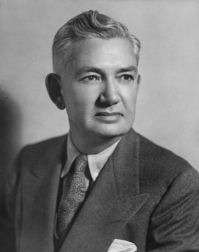Douglas Moore
Douglas Stuart Moore (August 10, 1893 – July 25, 1969) was an American composer, educator, and author. He wrote music for the theater, film, ballet and orchestra, but his greatest fame is associated with his operas The Devil and Daniel Webster (1938) and The Ballad of Baby Doe (1956).[1]

Biography
Moore was born in Cutchogue, Long Island, New York. His ancestors were among the first settlers to Long Island, NY. Moore was an alumnus of the Fessenden School, the Hotchkiss School and Yale University. Moore earned two degrees from Yale University, a B.A. in 1915, then a B.Mus in 1917.
Moore served in the Navy as a lieutenant, after which he studied music with Nadia Boulanger, Vincent d'Indy and Ernest Bloch in Paris.[2]
Moore served as president of the National Institute and American Academy of Arts and Letters, 1953 - 1956. He had been a member since 1941.[3]
In 1921, Moore was hired as Director of Music at the Cleveland Museum of Art, during which he studied with Ernest Bloch at the Cleveland Institute of Music, and performed in plays at The Cleveland Play House. He made his debut as a composer and conductor in 1923 conducting his Four Museum Pieces with the Cleveland Orchestra.
In 1926, Moore joined the music faculty at Columbia University, where he remained until his retirement in 1962. In 1954 he was a co-founder, with Otto Luening and Oliver Daniel, of the CRI (Composers Recordings, Inc.) record label.
Apart from classical compositions, Moore also composed several popular songs whilst at Yale together with poet and Hotchkiss School mate Archibald MacLeish and later in collaboration with John Jacob Niles. He wrote the Yale fight song Goodnight, Harvard. These songs were later published in 1921 under the collective title "Songs my Mother never taught Me". He later collaborated with fellow Yale alumnus Stephen Vincent Benet on the folk opera The Devil and Daniel Webster.
Moore authored two books on music, Listening to Music (1932) and From Madrigal to modern Music (1942).
Music
Moore's music is somewhat difficult to pigeonhole. Under the course of his artistic career he developed a highly personal musical language, basically romantic and richly tonal but with strong links to American folk music.
Influence during his musical education came especially from his teacher d'Indy (he didn't get on too well with Boulanger), at the Schola Cantorum de Paris, whose harmonic treatment had quite a large influence on Moore.
Moore is sometimes viewed as a conservative mainly because he tended to resist influence of the various musical vogues that arose, and ultimately fell, during his life. His chosen style was what some regard as "typically American" i.e. based on American folk music, though Moore never actually used any authentic folk tunes but rather created his own (much like Gustav Holst or Falla). The creation of this style was greatly bolstered by Vachel Lindsay in the twenties, though Moore also allowed other styles influence him, such as jazz and ragtime. This is most readily apparent in his operas. The Ballad of Baby Doe has several rag elements (a honky-tonk piano is used extensively in the first scene) and in his 1958 "soap opera" Gallantry, the commercials for Lochinvar soap and Billy Boy wax are sung in a blueslike fashion. Furthermore, the allegretto from his second symphony has an almost neoclassical clarity to it.
One distinguishing characteristic of Douglas Moore's music is the modesty, grace and tender lyricism that mark the slower passages of his many works, especially his Symphony in A major and the clarinet quintet. The faster movements of the aforementioned compositions have a robust, jovial and a somewhat terpsichorean quality. Admittedly though, Moore was slower in development when it came to purely orchestral works and most of his energy was directed towards opera. He wrote eight operas, mostly on American subjects, though one notable exception is Giants in the Earth for which he won the 1951 Pulitzer Prize for Music.
Selected works
Stage works
- Twelfth Night, incidental music (1927)
- Greek Games, ballet (1930)
- White Wings, chamber opera (1935)
- The Headless Horseman, operetta (1936)
- The Devil and Daniel Webster, folk opera (1939)
- Giants in the Earth, opera (1949–50, won the Pulitzer Prize in 1951)
- The Ballad of Baby Doe, opera (1956)
- Gallantry, a soap opera (1958)
- The Wings of the Dove, opera (1961)
- Carry Nation, opera (1966)
Orchestral works
- Four Museum Pieces (1923)
- The Pageant of P.T. Barnum, suite (1924)
- Moby Dick, symphonic poem (1928)
- A Symphony of Autumn (1928–30)
- Overture on an American Tune (1932)
- Village Music, suite (1941)
- In memoriam (1943)
- Down East suite, also arranged for violin and piano (1944)
- Symphony No. 2 in A major (1945)
- Farm Journal, suite (1947)
- Cotillion Suite (1952)
Chamber works
- Violin sonata (1929)
- String quartet (1933)
- Quintet for woodwinds and horn (1942)
- Quintet for clarinet and strings (1946)
- Piano trio (1953)
Film music
- Power in the Land (1940, material later used for Farm Journal in 1947)
- Youth Gets a Break (1940)
- Bip Goes to Town (1941)
- Power for the Parkinsons (2009)
References
- New York Times obituary
- The Columbia Encyclopedia, Sixth Edition, Columbia University Press, 2000
- A Century of Arts & Letters, The History of the National Institute of Arts & Letters and the American Academy of Arts & Letters as Told, Decade by Decade, by Eleven Members, John Updike, Editor, pp. 118, 136 and 137, Columbia University Press, New York, 1998